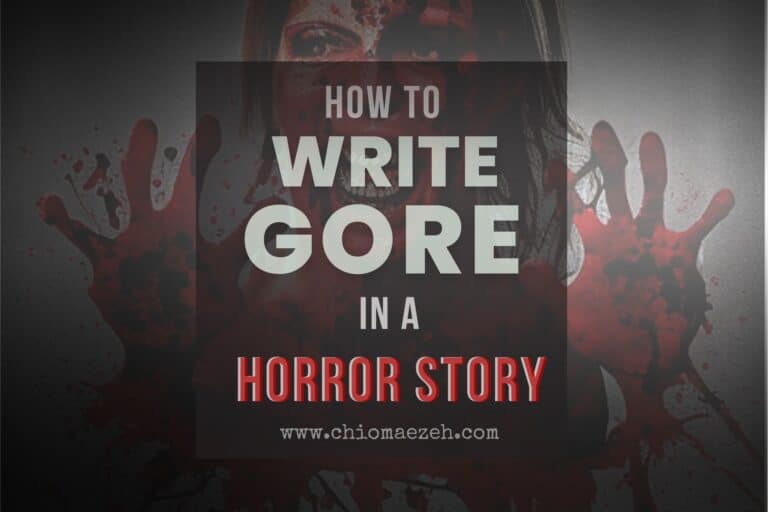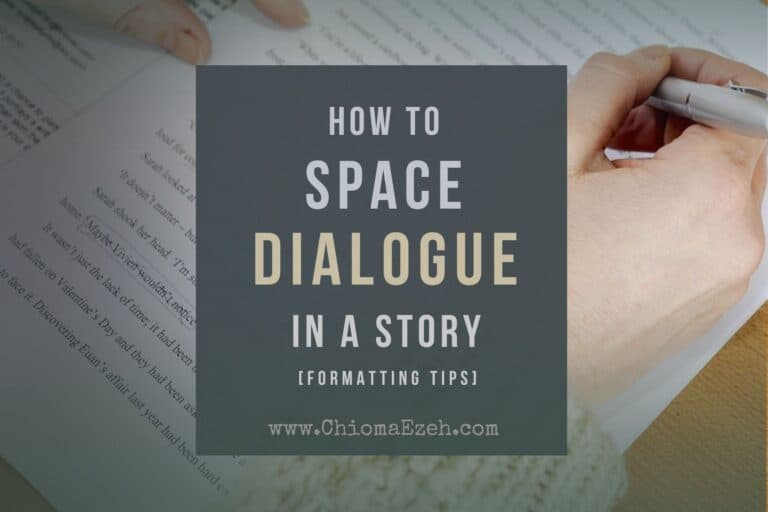What Is A Subplot In A Story? [Definition & Examples]
You may be wondering “what is a subplot in a story.” A subplot is like a mini-story inside a bigger or main story. Let’s say you’re reading a book about a detective trying to solve a big mystery – that’s the main plot.
But maybe the detective also has a rocky relationship with his daughter. This smaller story of them trying to mend their relationship would be a subplot. It’s not the main focus, but it gives us more information about the characters (detective and his daughter) and keeps things exciting.
This article will help you understand what a subplot is, show you examples from famous books and movies, and give tips on creating your own subplots! Here’s a sneak peek at what you’ll learn:
- What is a subplot and its role in a story?
- Examples of subplots from popular literature and films.
- How subplots enrich the main plot and characters.
- Tips for writing subplots in your story.
👉
Let’s Talk
Are you a writer aspiring to pen a masterpiece that never fails to captivate? Look no further. Reach out to us and uncover how we can help you to take your writing to unprecedented heights!

Subplot Definition: What Is A Subplot?
A subplot, sometimes referred to as a “B story” or “C story,” is a secondary plot that runs alongside the main plot in fiction, such as novels, movies, TV shows, and plays.
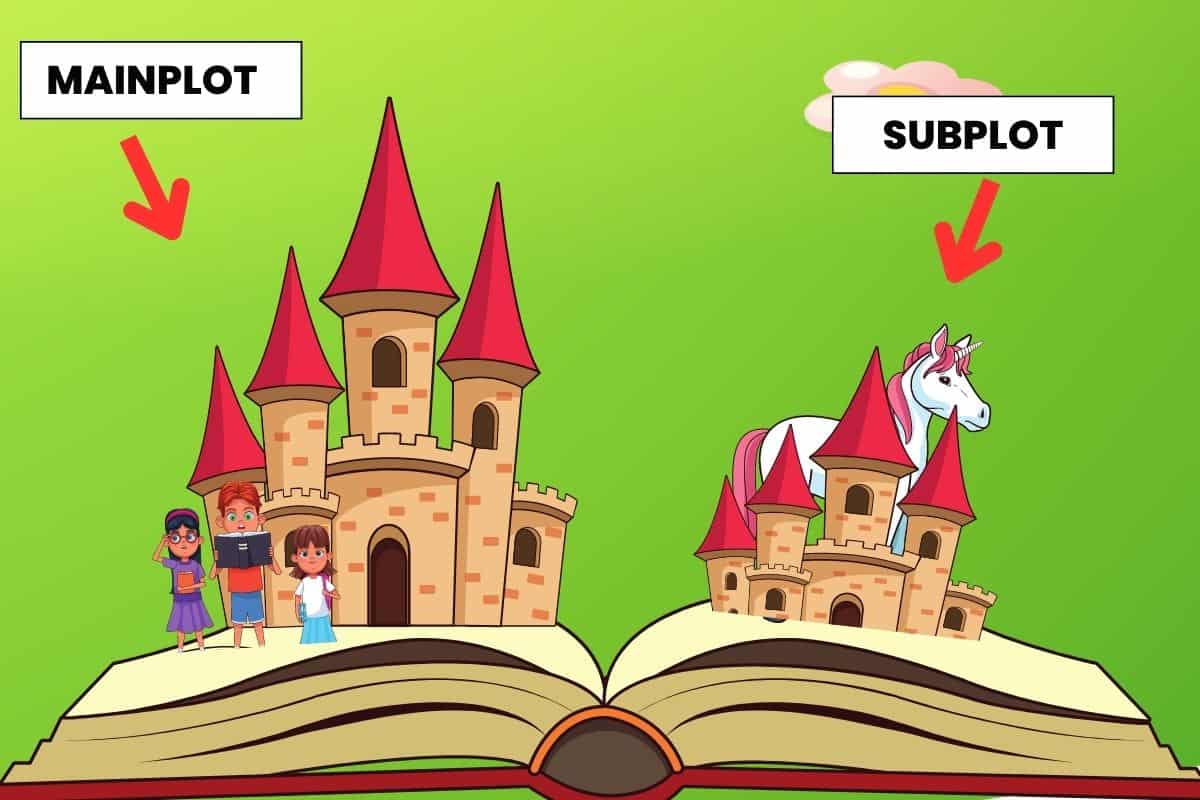
This supporting side story not only adds depth and complexity to the primary narrative but also enhances character development and assists in building intrigue for the audience.
Think of a subplot in literature, as a “mini-story” that happens alongside the main story. This mini-story adds extra layers to the main story and helps us understand the characters better. For example, in Harry Potter, while our protagonist Harry is off fighting Voldemort, we also see Ron and Hermione becoming closer friends and eventually falling in love. That’s a subplot!
Although subplots are designed to support rather than overshadow the principal narrative arc, they enrich storytelling by contributing diverse perspectives on central themes.
Why Are Subplots Important?
Subplots make the main story more interesting. They help us learn more about the story’s characters, and the subplot lines can show us different aspects of the story’s main conflict or themes. They give us more information about the major characters and themes. So, they help develop themes and reinforce messages in the story.
In “Great Expectations,” for example, we see side stories about minor characters that help us understand the main character and themes of social class and morality. Plus, subplots let us see the main characters from different angles and help us feel more connected to them.
Using subplots is a great way to give readers fresh perspectives on your main character’s motivations, which may not be obvious from the beginning.
How And Where Do Subplots Fit Into A Story?
Subplots can be introduced anywhere in a story. Often, they start in the first act of a story when we’re still learning about the story’s main plot and characters. But they can also pop up later in the second act, when things start getting more intense, to keep us interested and add more depth to the story.
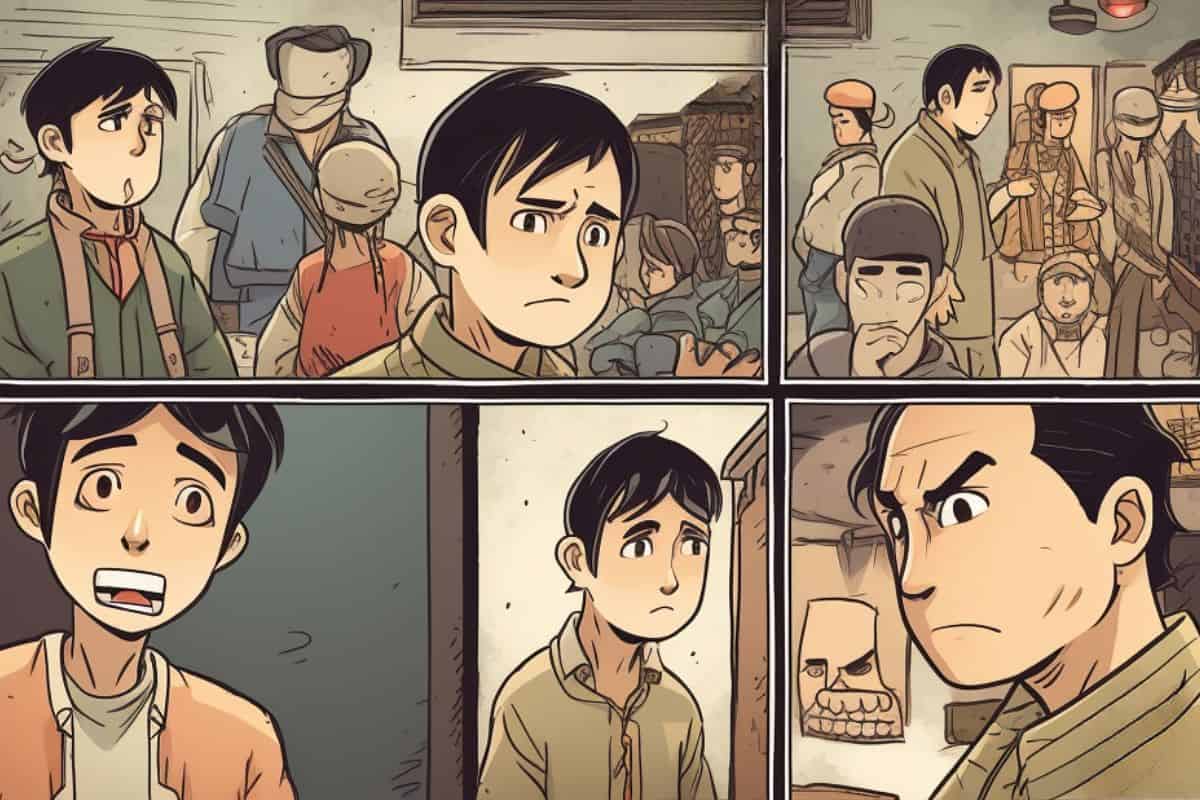
Here’s an explanation of how subplots fit into two popular story structures:
1. Subplot In Three-Act Structure:
This way of telling a story is split into three parts or ‘acts’—the Setup, the Confrontation, and the Resolution.
- Setup (Act One): In this part, we meet the main characters and learn about the big problem or goal. If there’s a subplot, we might start to see it here too.
- Confrontation (Act Two): This is the middle part of the story where the main characters are trying to solve their problem or reach their goal. If there’s a subplot, it will get more interesting here, and the characters in the subplot might change or learn something important.
- Resolution (Act Three): By this point, the main problem or goal should be solved or reached. If there’s a subplot, it should also wrap up here. How the subplot ends can often relate back to the main story in a meaningful way.
2. Subplot In Freytag’s Pyramid:
This is another way to structure a story. It has five parts—Exposition, Rising Action, Climax, Falling Action, and Denouement.
- Exposition: This is where we meet the characters and discover their problem or goal. If there’s a subplot, we might start seeing it here, introducing more problems or goals for other characters.
- Rising Action: This is where the main story and subplots get more intense. The problems or goals become harder to solve or reach.
- Climax: This is the most exciting part of the story. The main story and any subplots reach their most intense point. The climax of the subplots often helps to make the main story more exciting.
- Falling Action: This is where the characters start to solve their problems or reach their goals. Any subplots should start to wrap up here, too.
- Denouement: This is the very end of the story. Everything wraps up, including any subplots. Any remaining questions from the subplot(s) should be answered here, offering more closure to the overall story.
In both of these story structures, the subplot should add to and reflect the main story, working together with it. Make sure that subplots wrap up by the end and they contribute in a meaningful way to the main story or its message.
Types of Subplots
- Character-Based Subplots: These subplots are all about developing the characters. They show us the characters’ strengths, weaknesses, and relationships.
- Theme-Based Subplots: These subplots enhance the main theme of the story.
- Conflict-Based Subplots: These subplots add more challenges for the main character to face, making the story more exciting.
- Romantic Subplots: These subplots show the love interests of the main or secondary characters.
- Mystery or Suspense Subplots: These subplots add a sense of mystery or suspense to the story.
- Parallel Plots: These subplots run alongside the main plot and meet at some point, showing connections between different characters and events.
- Mirror Plots: These subplots reflect the main character’s struggles, helping us understand and relate to the characters more deeply.
Why You Should Use Subplots In Your Story
Subplots are mini-stories in your main story and they make your story better. Subplots make your story deeper, more complex, and more exciting.
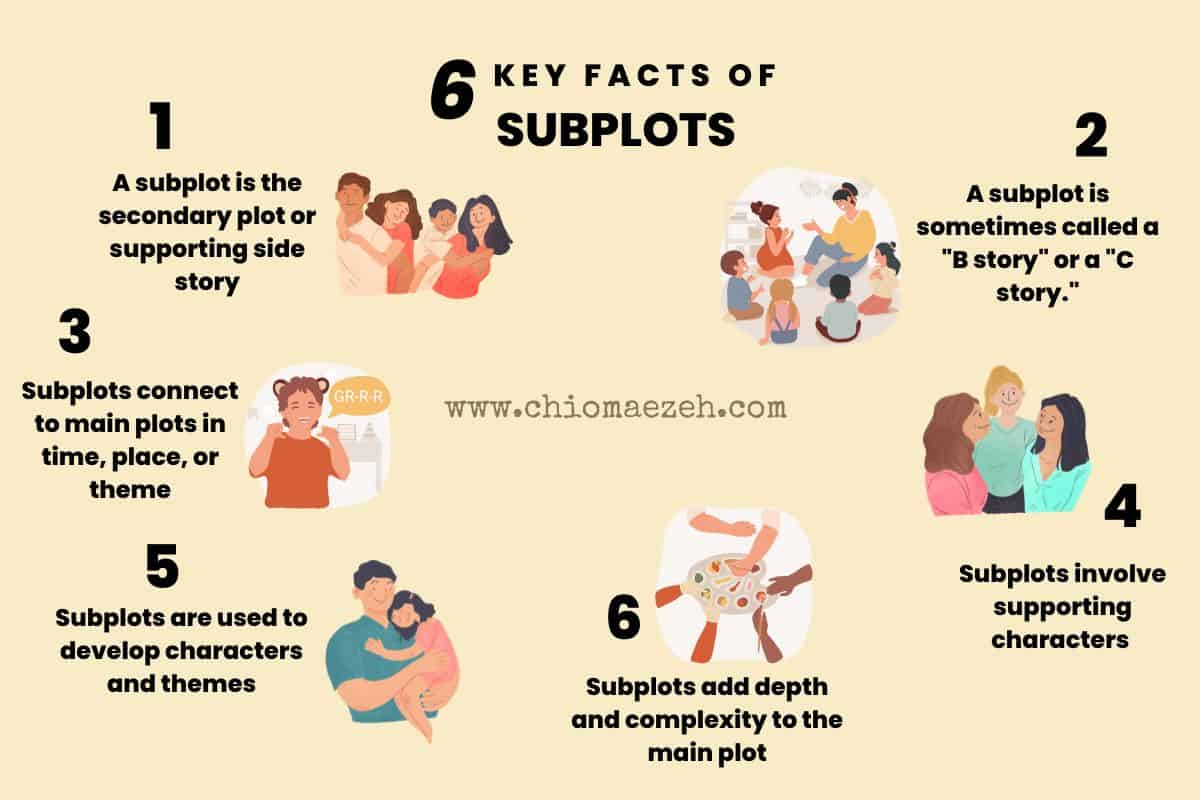
Here are five reasons you should consider about using subplots in your story:
- Develop Characters: Subplots let you show more about your main and minor characters. You can show their lives and reasons for doing things. This helps make all your characters seem real and easy to relate to.
- Stronger Themes: By including subplots in your main story, you can make your main message or theme stronger without making your main plot too heavy.
- Keep Readers Engaged: A subplot can add more mystery that keeps readers wanting to read more. Your readers get to follow many small stories simultaneously, making them want to stay in your story’s world.
- Vary the Pacing: Using different subplots, you can balance the pace of your story. You can use it to lighten the mood when the main story gets too heavy.
- Add More Complexity: When you mix subplots well into your story, it makes your story seem deeper and more complicated. And your readers will have a more enjoyable time reading.
Subplot Case Study: Children’s Subplot Story
Ella and Jack’s discovery

Imagine this short story:
Main Plot: In the lush, green expanse of their grandparents’ backyard, four kids find pure joy on an old, sturdy swing. Their laughter fills the air, bringing the tranquil garden to life. They take turns on the swing, pushing each other into the sky, and their cheerful noises create a lively atmosphere of childhood fun.
Subplot: While the excitement of the swing continues, two of the kids, brother, and sister Ella and Jack, uncover a different adventure. They find two old, still useable toy horses tucked away in the garden shed. This discovery sparks their imaginations, and the backyard transforms into the wild frontier of the Old West.
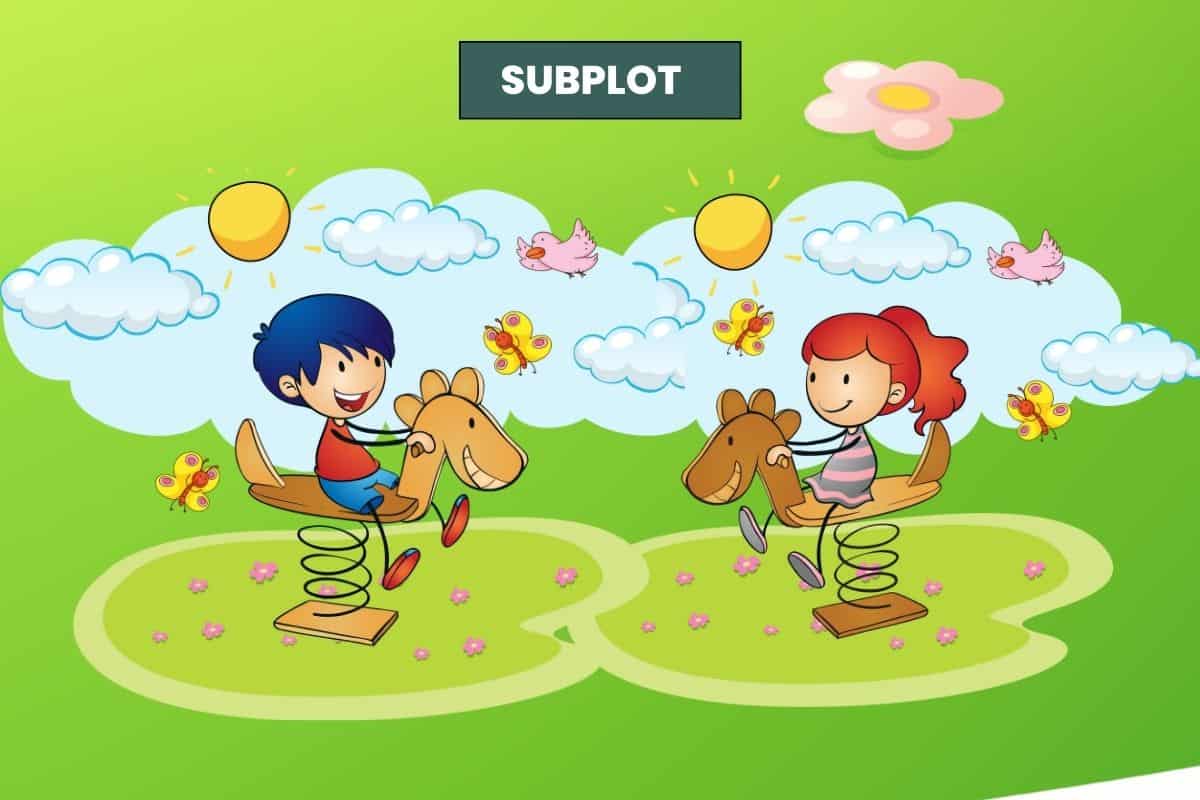
With the other two kids still playing happily on the swing, Ella and Jack launch into their own imaginative play. Astride their toy horses, they pretend to be cowboys and cowgirls, engaging in exciting chases, mock fights, and dramatic rescues.
Their imaginative play entertains them and deepens their bond as siblings, adding a different yet equally joyful layer to the overall garden fun.

The subplot in this story, about Ella and Jack finding and playing with toy horses, is important for a few reasons:
- Character Growth: This substory helps us learn more about Ella and Jack. When they play their imaginative game, we see how creative and brave they are, and how close they are as brother and sister. This adventure makes them different from the other kids and shows us more about who they are.
- Contrast and Variety: The main story talks about how all the kids are having fun with a swing. But the fun Ella and Jack have with their toy horses shows us a new and equally exciting way to play. This makes the story more diverse and fun to read.
- Enhance Theme: If the main idea of the story is about how pure and creative kids can be, this extra story really drives that home. The way Ella and Jack turn the garden into their own Wild West shows us that a child’s imagination can take them anywhere.
- Emotional Complexity: The extra story adds more feelings to the overall story. As Ella and Jack’s friendship grows stronger, as they have friendly competitions, it makes us feel more connected to them and improves the story.
4 Popular Examples Of Subplot In Literature
1. Subplot Example In Harry Potter series by J.K. Rowling:
In the Harry Potter books, a love story between Ron Weasley and Hermione Granger adds more to the main story and helps us better understand the main characters.
This romantic subplot helps show how Ron and Hermione change over time. At first, they’re always arguing, but as the story goes on, they become a couple in love. This is a lighter part of the story that goes against some of the darker main story parts.
Their relationship makes the magic world of Hogwarts seem more real and helps us understand and feel for the characters more. The love story also reminds us of the importance of love, friendship, and loyalty, even when things get scary.
2. Example of a Subplot In The Great Gatsby by F. Scott Fitzgerald:
In The Great Gatsby, a romantic subplot about Tom Buchanan and Myrtle Wilson having an affair. This story shows how some rich people in the 1920s didn’t have good morals.
This side story shows that some rich people didn’t care about right or wrong, which differs from Gatsby’s love for Daisy.
The story also shows how chasing money and status can lead to bad things, like how Myrtle’s wish to be rich leads to her sad ending. This affair also changes the main story’s direction, leading to events that end in Gatsby’s death. This brings out the themes of love, friendship, and loyalty amidst the battles against dark forces and how the American Dream can be empty.
3. Example of a Subplot In Pride and Prejudice by Jane Austen:
In Pride and Prejudice, the love stories, especially between Jane Bennet and Mr. Bingley and Elizabeth Bennet and Mr. Darcy, highlight the story’s themes about social rules, class differences, and personal relationships.
Jane and Bingley’s relationship is pretty simple, showing the usual expectations of dating and marriage. On the other hand, Elizabeth and Darcy’s relationship has prejudice, misunderstandings, and learning about themselves, showing the story’s message about social expectations and the importance of personal growth.
These side love stories or subplots make the main story more interesting and allow the author to show different views on love and marriage in the early 1800s in England.
4. Example of a Subplot In Game of Thrones series by George R.R. Martin:
In the Game of Thrones books, the political subplot about different noble houses fighting for power show the complicated politics of Westeros and help build up minor characters into main characters in the overall story.
These side stories, which are as interesting and complicated as the main story, make the story more engaging. They expand the world and its politics, showing the results of ambition, betrayal, and honor in a tough world.
These side stories also help minor characters become more important, bringing unexpected turns to the main story.
Subplots are a good way to make the main story more complicated and interesting. When used correctly, subplots can give valuable lessons that can be used in different kinds of stories, from books to movies and video games.
Subplot Practice: A Helpful Guide for Writers
Here’s a simple guide to help you write a subplot:
Identify the Main Plot: What’s the main story? What’s the big problem your main character is trying to solve?
Decide the Purpose of the Subplot: Think about what your subplot will do. Will it help develop a character, introduce more conflicts, add depth to the main plot, or give a break from the main story?
Create Characters for the Subplot: If your subplot includes new characters, develop them like your main characters. They should have their own motivations, problems, and story arcs. If it involves existing characters, think about how the subplot will reveal more about them.
Plan the Subplot Storyline: What are the key events in the subplot? Remember, a subplot should have its own mini-story: a beginning, middle, and end.
Link the Subplot to the Main Plot: How will the subplot connect to the main plot? Will it mirror the main plot, contrast it, or give important information? The subplot should always influence or connect with the main plot in some way.
Insert the Subplot into the Main Plot: Decide where and how to add the subplot into the main plot. It can be mixed into the main plot or happen in its own sections.
Resolve the Subplot: Make sure the subplot ends before or at the same time as the main plot. Leaving a subplot unresolved can leave readers feeling unsatisfied.
Review and Revise: Lastly, check your subplot. Does it add to the main plot, or characters? If it doesn’t, revise it until it does.
Subplots in Different Genres
How you use subplots can vary depending on your genre. Here are some examples:
- Mystery: The detective might have a romantic subplot that tests their dedication to the case, or a backstory subplot revealing why they became a detective.
- Fantasy: There could be a subplot involving a secondary character’s struggle with magic, which later helps the main character in an important battle.
- Romance: A subplot could focus on a best friend who initially gives terrible relationship advice but learns about love themselves along the way.
- Science Fiction: There might be a subplot showing the ethical implications of a technology used in the main plot.
- Thriller: A subplot could revolve around a character overcoming their past trauma, which helps them face the danger of the main plot.
Remember, subplots are meant to enhance your main story and should always connect back to the main plot or character’s journey in some way.
Reasons To Use Subplots
Adding several subplots in to your story can make it much more interesting and engaging. They add depth and complexity to your whole story arc. Here are some reasons to use subplots:
- Character Development: Subplots let us explore the characters more deeply, making them seem more real and relatable.
- Thematic Depth: Subplots can highlight the story’s main themes in a subtle way, reinforcing the story’s message without making it too obvious.
- Increased Engagement: Subplots create more layers to the story, which can keep readers interested and engaged.
- Varied Pacing: By mixing in lighter subplots with more intense moments, you can control the story’s pace and keep it from becoming too heavy.
- Greater Complexity: Well-integrated subplots make the story feel deeper and more intricate, providing a richer reading experience.
FAQs On Subplot In A Story
1. What is a subplot in literature or film-making?
A subplot is a secondary storyline in a work of fiction that exists alongside the main plot, often featuring its own unique characters and conflicts that may affect the primary story in significant ways.
2. What purpose does a subplot serve?
Subplots can provide additional depth to the themes and characters of a work, creating more opportunities for tension and drama beyond the main plotline. Deviations from the primary narrative may reflect social issues, examine relationships between supporting characters, and add greater complexity to an overarching central conflict.
3. How Are Subplots Used In Literature?
Subplots are a powerful tool used in literature to add depth and complexity to the main storyline. They are used is to provide context for the story’s main conflict. Subplots also offer an opportunity for character development beyond what can be achieved through the story’s main plot.
4. How do you differentiate between a subplot and other literary techniques like foreshadowing or symbolism?
Foreshadowing hints at future events, while symbols may represent abstract concepts such as freedom or love. A subplot is identifiable by having fully developed plotlines with their start points, challenges, resolutions & endings – all without serving as distractions but rather supporting & enhancing the development of the main theme/characters.
5. How can writers effectively incorporate subplots into their works?
Writers should incorporate subplots not to derail focus from the core narrative. A useful approach would be to ensure reasonable parallels between our defined symbolisms/themes within each separate strand to avoid further confusing your readers. Hence, they are easier to place neatly in the final piece. Also, the size must not overshadow the significance! Sub-plots should only accompany the center stage theme, and not overpower it.
Conclusion: What Are Subplots in a Story?
In summary, a subplot is a secondary plot that supports the main story in literature, movies, TV shows, or plays. It adds depth and complexity to the story without overpowering the main plot.
Subplots involve supporting characters and can reveal new information about the main character’s development and themes. Incorporating subplots in fiction writing requires careful planning, but it can enhance the overall storyline.
As writers, we should remember that effectively using subplots keeps our audience engaged by providing valuable lessons through the characters’ experiences and challenges.
7 Types Of Plot In Literature
The magic of a good story lies in its plot structure. This is the skeleton of a story, a way to arrange the story plot’s main points in a way that makes sense. This helps to create a complete narrative where events in the story have a cause and effect relationship. Let’s talk about the seven basic plots that most stories follow.
- Overcoming the Monster: The main character or protagonist faces a big, scary problem – like a dragon or a villain. Think of Harry Potter in “Sorcerer’s Stone”. He had to face a challenging situation, fighting against Lord Voldemort. This plot structure is like a mountain with a peak – the story’s climax – where the protagonist fights the monster.
- Rags to Riches: In this plot, the story begins with the main character in a sad or tough situation. But, through a series of major events, they find a happy ending. Cinderella is a good example. She starts as a little girl in rags, but by the story’s end, she’s a princess. This plot’s basic structure can be seen as a ladder, with each step up as a plot point leading to the top.
- The Quest: Here, the main character and other characters go on a journey to achieve something important. In most stories like these, there are plot devices – or special events – that help the main character get closer to their goal. The Harry Potter series is full of such quests.
- Voyage and Return: In these plot examples, one character goes to an unknown place, learns something important, and then returns home as a changed person. This story plot follows a round shape, like a circle, the character leaves home, has an adventure, and returns home again.
- Comedy: This plot can make a reader feel emotion, and often, it makes them laugh. It’s like a tangled ball of string, with many plot points confused, but then everything gets sorted out. The funniest part? Many times, two characters are mixed up about something – like in “A Midsummer Night’s Dream”.
- Tragedy: This is a story where the main character’s mistakes lead to destructive or painful action. It’s like a mountain, but instead of climbing up to a happy ending, the character slides down into trouble. Remember “Romeo and Juliet?” That’s a tragedy.
- Rebirth: This plot has a special plot device – the bad or not-so-nice main character becomes good. It’s like a U-shape, the character starts up high, falls down into trouble, and then rises up again, like Scrooge in “A Christmas Carol”.
Different Types Of Plot Structures
Plot structure is the framework that shapes a story. The plot structure provides a clear and organized order of events. It’s a key part of creating engaging fiction, as it helps writers stay focused on the story while making sure that every event has a purpose and is important.
There are many ways, or plot structures, to arrange events in a story. Let’s look at four main types: linear, non-linear, episodic, and emergent.
- Linear Plot Structure: A linear plot structure is like a straight line. The story begins at the start, moves through the middle, and ends at the finish. All the events happen in order, one after the other. This is easy for readers to follow and understand.
- It usually follows the order – exposition, rising action, climax, falling action, and resolution – one after the other without change in time sequence.
- Many stories use this structure, including most Harry Potter books. It can build tension, suspense, and excitement as readers wonder what will happen next.
- Non-linear Plot Structure: In a non-linear plot structure, events don’t happen in order. Instead, the story might jump around in time. It could include flashbacks to the past, time jumps, or parallel storylines.
- This type of structure keeps readers guessing about what will happen next. It can make a story more exciting and different. Some books with non-linear plots are “The Time Traveler’s Wife” and “Slaughterhouse-Five.”
- 3Episodic Plot Structure
- An episodic plot structure is like a series of short stories or episodes, all linked together. It derives from the name “episodes.” Each episode has its own little plot, conflict, and resolution but is connected to the other episodes in some way.
- Many TV shows use this structure. For example, in “Friends,” each episode has its own story, but all are part of the main story about friendship.
- This type of structure can be fun if you want to write about different things happening to your characters without having to stick to one main plot.
- 4. Emergent Plot Structure
- In an emergent plot structure, the story unfolds as it goes along. It is a type of non-linear plot. The writer doesn’t plan the whole story in advance but instead lets it grow and change naturally.
- This type of structure can be challenging, but it can also lead to unexpected and exciting story twists. The book “A Confederacy of Dunces” is an example of an emergent plot structure.

![What Is Gore In Horror Writing? [Definition, Examples]](https://chiomaezeh.com/wp-content/uploads/2023/05/what-is-gore-in-horror-1-768x512.jpg)
![How To Write A Story Outline In 6 Steps [Simple Visual Guide]](https://chiomaezeh.com/wp-content/uploads/2023/02/How-to-write-a-story-outline-2-768x512.jpg)
![How to Create Tension In A Story With Setting [Examples]](https://chiomaezeh.com/wp-content/uploads/2023/04/how-to-create-tension-in-a-story-with-setting-768x512.jpg)
